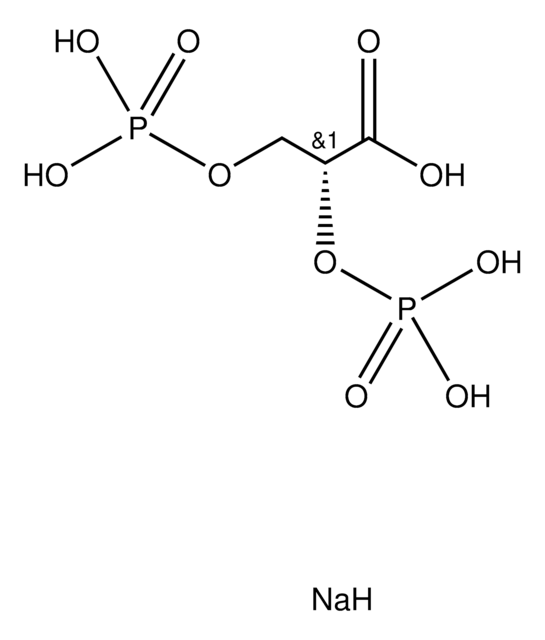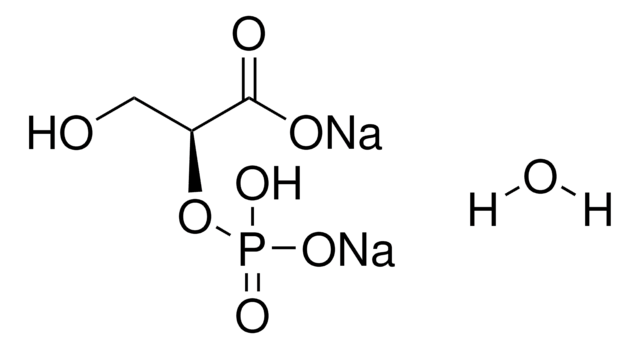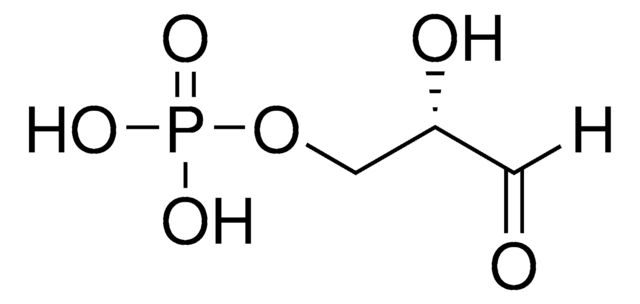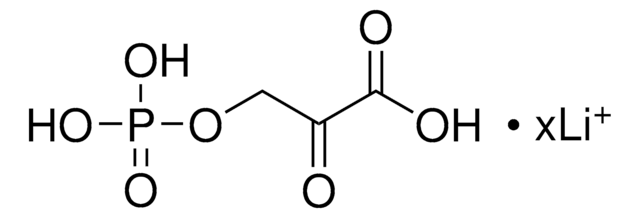P8877
D-(−)-3-Phosphoglyceric acid disodium salt
≥93% dry basis (enzymatic), powder
Sinonimo/i:
(−)-Disodium D-3-phosphoglycerate, D-Glycerate 3-phosphate disodium salt
About This Item
Prodotti consigliati
Origine biologica
synthetic (inorganic)
Livello qualitativo
Saggio
≥93% dry basis (enzymatic)
Stato
powder
Caratteristiche più verdi
Atom Economy
Design for Energy Efficiency
Use of Renewable Feedstocks
Learn more about the Principles of Green Chemistry.
sustainability
Greener Alternative Product
Impurezze
<14% water (NMR)
Colore
white
Solubilità
H2O: 50 mg/mL, clear, colorless to faintly yellow
Cationi in tracce
Na: 18-22% (dry basis)
Categoria alternativa più verde
Temperatura di conservazione
−20°C
Stringa SMILE
[Na+].[Na+].O[C@H](COP(O)([O-])=O)C([O-])=O
InChI
1S/C3H7O7P.2Na/c4-2(3(5)6)1-10-11(7,8)9;;/h2,4H,1H2,(H,5,6)(H2,7,8,9);;/q;2*+1/p-2/t2-;;/m1../s1
RGCJWQYUZHTJBE-YBBRRFGFSA-L
Cerchi prodotti simili? Visita Guida al confronto tra prodotti
Applicazioni
Azioni biochim/fisiol
Altre note
Avvertenze
Warning
Indicazioni di pericolo
Consigli di prudenza
Classi di pericolo
Eye Irrit. 2 - Skin Irrit. 2 - STOT SE 2 - STOT SE 3
Organi bersaglio
Eyes,Central nervous system, Respiratory system
Codice della classe di stoccaggio
11 - Combustible Solids
Classe di pericolosità dell'acqua (WGK)
WGK 3
Scegli una delle versioni più recenti:
Possiedi già questo prodotto?
I documenti relativi ai prodotti acquistati recentemente sono disponibili nell’Archivio dei documenti.
I clienti hanno visto anche
Articoli
Learn about monosaccharide biosynthesis and the metabolism of monosaccharides. A unit of a carbohydrate and the simplest form of a sugar, a monosaccharide cannot be hydrolyzed into a simpler compound.
Review the 10 steps of glycolysis in the Embden-Meyerhof-Parnas glycolytic pathway. Easily compare reaction stages and buy the enzymes for your life science research.
Neoplastic cells are highly dependent on the de novo synthesis of nucleotides to maintain sufficient pools to support DNA replication and the production of RNA.
We presents an article about the Warburg effect, and how it is the enhanced conversion of glucose to lactate observed in tumor cells, even in the presence of normal levels of oxygen. Otto Heinrich Warburg demonstrated in 1924 that cancer cells show an increased dependence on glycolysis to meet their energy needs, regardless of whether they were well-oxygenated or not.
Il team dei nostri ricercatori vanta grande esperienza in tutte le aree della ricerca quali Life Science, scienza dei materiali, sintesi chimica, cromatografia, discipline analitiche, ecc..
Contatta l'Assistenza Tecnica.














